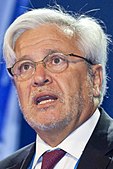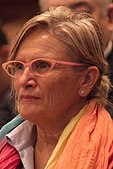The 2003 Barcelona City Council election, also the 2003 Barcelona municipal election, was held on Sunday, 25 May 2003, to elect the 7th City Council of the municipality of Barcelona. All 41 seats in the City Council were up for election. The election was held simultaneously with regional elections in thirteen autonomous communities and local elections all throughout Spain.
| ||||||||||||||||||||||||||||||||||||||||||||||||||||||||||||||||||||||||||||||||||
All 41 seats in the City Council of Barcelona 21 seats needed for a majority | ||||||||||||||||||||||||||||||||||||||||||||||||||||||||||||||||||||||||||||||||||
|---|---|---|---|---|---|---|---|---|---|---|---|---|---|---|---|---|---|---|---|---|---|---|---|---|---|---|---|---|---|---|---|---|---|---|---|---|---|---|---|---|---|---|---|---|---|---|---|---|---|---|---|---|---|---|---|---|---|---|---|---|---|---|---|---|---|---|---|---|---|---|---|---|---|---|---|---|---|---|---|---|---|---|
| Registered | 1,281,534 | |||||||||||||||||||||||||||||||||||||||||||||||||||||||||||||||||||||||||||||||||
| Turnout | 759,197 (59.2%) | |||||||||||||||||||||||||||||||||||||||||||||||||||||||||||||||||||||||||||||||||
| ||||||||||||||||||||||||||||||||||||||||||||||||||||||||||||||||||||||||||||||||||
| ||||||||||||||||||||||||||||||||||||||||||||||||||||||||||||||||||||||||||||||||||
Electoral system
editThe City Council of Barcelona (Catalan: Ajuntament de Barcelona, Spanish: Ayuntamiento de Barcelona) was the top-tier administrative and governing body of the municipality of Barcelona, composed of the mayor, the government council and the elected plenary assembly.[1] Elections to the local councils in Spain were fixed for the fourth Sunday of May every four years.[2] Voting for the local assembly was on the basis of universal suffrage, which comprised all nationals over 18 years of age, registered in the municipality of Barcelona and in full enjoyment of their political rights, as well as resident non-national European citizens and those whose country of origin allowed Spanish nationals to vote in their own elections by virtue of a treaty.
Local councillors were elected using the D'Hondt method and a closed list proportional representation, with an electoral threshold of five percent of valid votes—which included blank ballots—being applied in each local council.[1][2] Councillors were allocated to municipal councils based on the following scale:
| Population | Councillors |
|---|---|
| <250 | 5 |
| 251–1,000 | 7 |
| 1,001–2,000 | 9 |
| 2,001–5,000 | 11 |
| 5,001–10,000 | 13 |
| 10,001–20,000 | 17 |
| 20,001–50,000 | 21 |
| 50,001–100,000 | 25 |
| >100,001 | +1 per each 100,000 inhabitants or fraction +1 if total is an even number |
The mayor was indirectly elected by the plenary assembly. A legal clause required that mayoral candidates earned the vote of an absolute majority of councillors, or else the candidate of the most-voted party in the assembly was to be automatically appointed to the post. In the event of a tie, the appointee would be determined by lot.[1]
The electoral law allowed for parties and federations registered in the interior ministry, coalitions and groupings of electors to present lists of candidates. Parties and federations intending to form a coalition ahead of an election were required to inform the relevant Electoral Commission within ten days of the election call, whereas groupings of electors needed to secure the signature of a determined amount of the electors registered in the municipality for which they were seeking election, disallowing electors from signing for more than one list of candidates. For the case of Barcelona, as its population was over 1,000,001, at least 8,000 signatures were required.[2]
Results
edit| Parties and alliances | Popular vote | Seats | ||||
|---|---|---|---|---|---|---|
| Votes | % | ±pp | Total | +/− | ||
| Socialists' Party of Catalonia–Municipal Progress (PSC–PM) | 254,223 | 33.60 | –11.59 | 15 | –5 | |
| Convergence and Union (CiU) | 162,010 | 21.41 | –0.28 | 9 | –1 | |
| People's Party (PP) | 121,991 | 16.12 | +1.25 | 7 | +1 | |
| Republican Left of Catalonia–Municipal Agreement (ERC–AM) | 96,868 | 12.80 | +6.28 | 5 | +2 | |
| Initiative–Alternative Left–Agreement for Municipal Progress (ICV–EA–EPM)1 | 91,286 | 12.07 | +4.44 | 5 | +3 | |
| The Greens–Eco-pacifists of Catalonia (EV–Eco) | 5,449 | 0.72 | New | 0 | ±0 | |
| The Greens and More (ViM) | 3,955 | 0.52 | New | 0 | ±0 | |
| The Greens–Green Alternative (EV–AV) | 3,209 | 0.42 | New | 0 | ±0 | |
| Another Democracy is Possible (ODeP) | 1,143 | 0.15 | New | 0 | ±0 | |
| Unsubmissive Seats (Ei) | 731 | 0.10 | New | 0 | ±0 | |
| The Phalanx (FE) | 604 | 0.08 | –0.01 | 0 | ±0 | |
| Catalan State (EC) | 582 | 0.08 | ±0.00 | 0 | ±0 | |
| Democratic and Social Centre (CDS) | 539 | 0.07 | –0.04 | 0 | ±0 | |
| Humanist Party of Catalonia (PHC) | 503 | 0.07 | ±0.00 | 0 | ±0 | |
| Platform for Catalonia (PxC) | 333 | 0.04 | New | 0 | ±0 | |
| Internationalist Struggle (LI (LIT–CI)) | 264 | 0.03 | New | 0 | ±0 | |
| European Nation State (N) | 198 | 0.03 | ±0.00 | 0 | ±0 | |
| Blank ballots | 12,679 | 1.68 | –0.21 | |||
| Total | 756,567 | 41 | ±0 | |||
| Valid votes | 756,567 | 99.65 | +0.09 | |||
| Invalid votes | 2,630 | 0.35 | –0.09 | |||
| Votes cast / turnout | 759,197 | 59.24 | +7.71 | |||
| Abstentions | 522,337 | 40.76 | –7.71 | |||
| Registered voters | 1,281,534 | |||||
| Sources[3][4][5][6] | ||||||
Footnotes:
| ||||||
Notes
editReferences
edit- ^ a b c Ley 7/1985, de 2 de abril, Reguladora de las Bases del Régimen Local (Law 7) (in Spanish). 2 April 1985. Retrieved 30 June 2020.
- ^ a b c Ley Orgánica 5/1985, de 19 de junio, del Régimen Electoral General (Organic Law 5) (in Spanish). 19 June 1985. Retrieved 30 January 2020.
- ^ "Election Results. Municipal Elections 2003. Barcelona". Government of Catalonia (in Catalan). Retrieved 12 November 2017.
- ^ "Local election results, 25 May 2003" (PDF). Central Electoral Commission (in Spanish). Retrieved 16 February 2018.
- ^ "Electoral Results Consultation. Municipal. May 2003. Barcelona Municipality". Ministry of the Interior (in Spanish). Retrieved 12 November 2017.
- ^ "Eleccions municipals a Barcelona (1979 - 2015)". Historia Electoral.com (in Catalan). Retrieved 30 September 2017.




